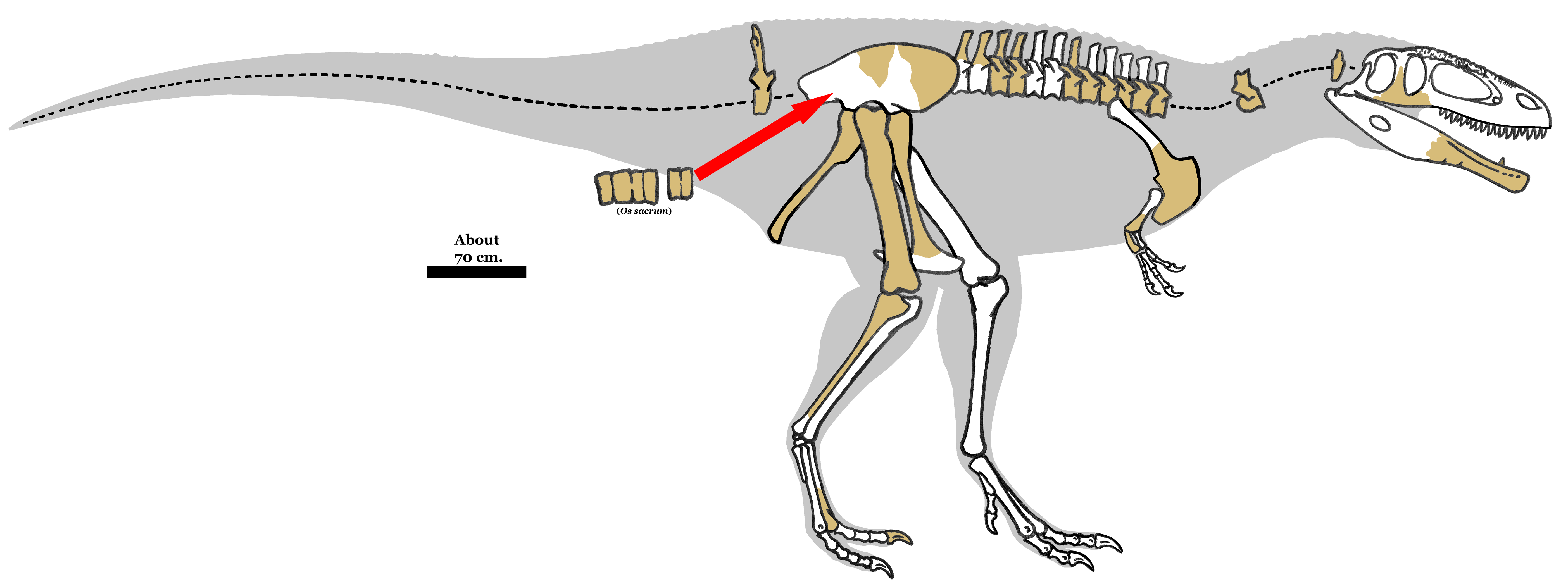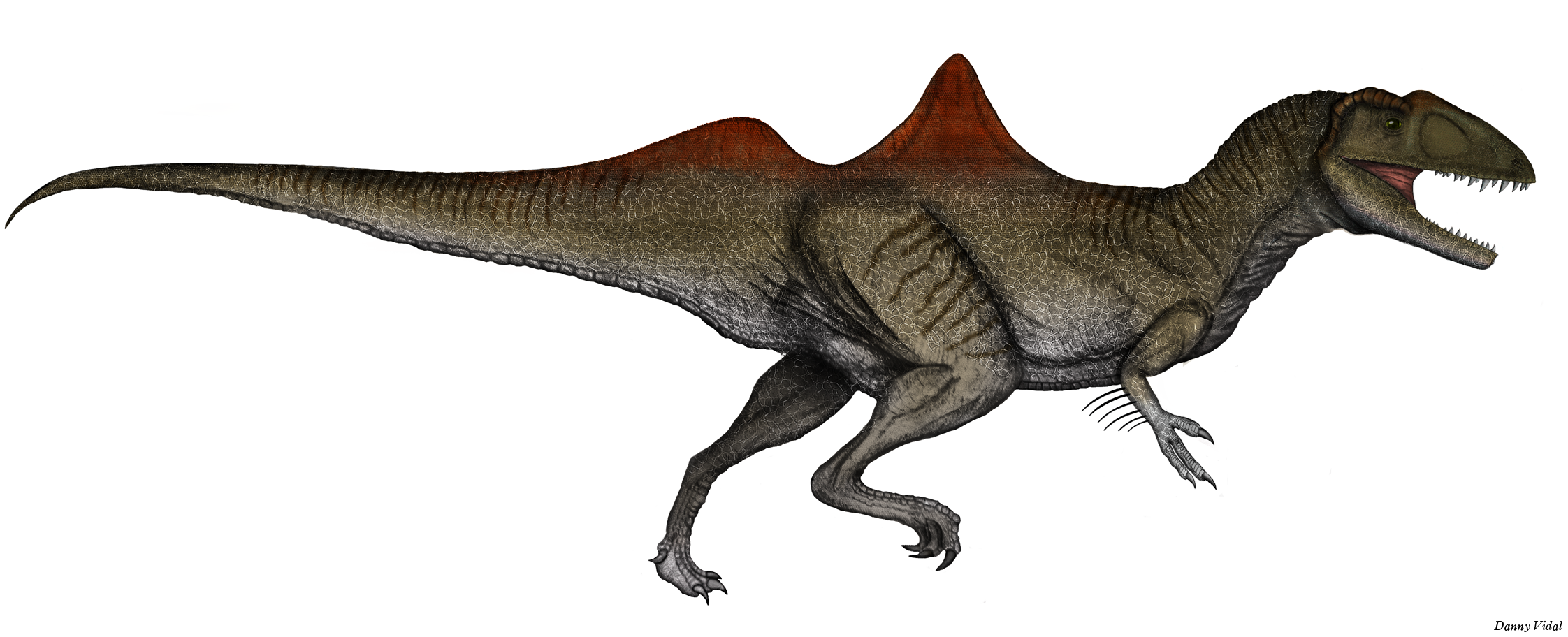|
Carcharodontosaurine
Carcharodontosauridae (carcharodontosaurids; from the Greek καρχαροδοντόσαυρος, ''carcharodontósauros'': "shark-toothed lizards") is a group of carnivorous theropod dinosaurs. In 1931, Ernst Stromer named Carcharodontosauridae as a family, which, in modern paleontology, indicates a clade within Carnosauria. Carcharodontosaurids include some of the largest land predators ever known: ''Giganotosaurus'', ''Mapusaurus'', ''Carcharodontosaurus'', and ''Tyrannotitan'' all rivaled ''Tyrannosaurus'' in size. Estimates give a maximum weight of for the largest carcharodontosaurids, while the smallest carcharodontosaurids were estimated to have weighed at least . Discovery and history The earliest discovery of carcharodontosaurid fossils may date to 1835 with the discovery of ''Poekilopleuron'' in Jurassic-aged sediments in Normandy, France and it was then described in 1836 by French naturalist Jacques Amand Eudes-Deslongchamps. However, the holotype (name-bearing) s ... [...More Info...] [...Related Items...] OR: [Wikipedia] [Google] [Baidu] |
Carcharodontosaurus
''Carcharodontosaurus'' (; ) is a genus of large carnivorous theropod dinosaur that lived in Northwest Africa from about 100 to 94 million years ago during the Cenomanian age of the Cretaceous. Two teeth of the genus, now lost, were first described from Algeria by French paleontologists Charles Depéret and Justin Savornin as ''Megalosaurus saharicus''. A partial skeleton initially referred to this genus was collected by crews of German paleontologist Ernst Stromer during a 1914 expedition to Egypt. Stromer did not report the Egyptian find until 1931, in which he dubbed the novel genus ''Carcharodontosaurus'', making the type species ''C. saharicus''. Although this skeleton was destroyed during the Second World War, it was subsequently redescribed as the holotype of a distinct carcharodontosaurid genus, '' Tameryraptor''. In 1995, a nearly complete skull of ''C. saharicus,'' the first well-preserved specimen to be found in almost a century, was discovered in the Kem Ke ... [...More Info...] [...Related Items...] OR: [Wikipedia] [Google] [Baidu] |
Tameryraptor
''Tameryraptor'' ("thief from the beloved land") is an extinct genus of large carcharodontosaurid dinosaur that lived during the Late Cretaceous (Cenomanian age) in what is now Egypt. It is known from a partial skeleton collected in rock layers from the Bahariya Formation by crews of German paleontologist Ernst Stromer in 1914, comprising an incomplete skull, vertebrae, and several other postcranial elements. Stromer described the specimen in 1931, referring it to the previously named ''Megalosaurus saharicus'' on the basis of its tooth anatomy, and placing it in a new genus, ''Carcharodontosaurus''. In 1944, it was destroyed in the Bombing of Munich in World War II, Bombing of Munich during the Second World War. The specimen remained assigned to ''Carcharodontosaurus saharicus'' until a review of photographs of the fossil material in 2025 allowed researchers to recognize the material as belonging to a distinct taxon known from a monotypic taxon, single species, ''Tameryraptor ma ... [...More Info...] [...Related Items...] OR: [Wikipedia] [Google] [Baidu] |
Tyrannotitan
''Tyrannotitan'' (; ) is a genus of large theropod dinosaur belonging to the carcharodontosaurid family. It is known from a single species, ''T. chubutensis'', which lived during the Albian stage of the Early Cretaceous period in what is now Argentina. Tyrannotitan is considered a close relative of other giant carcharodontosaurids from Gondwana, such as ''Carcharodontosaurus'', but it shares an especially close relationship with the South American carcharodontosaurids ''Giganotosaurus'' and ''Mapusaurus''. ''Tyrannotitan'' is known from a few specimens, however none of them are very complete. Discovery and species ''Tyrannotitan chubutensis'' was described by Fernando E. Novas, Silvina de Valais, Pat Vickers-Rich, and Tom Rich in 2005. The fossils were found at La Juanita Farm, northeast of Paso de Indios, Chubut Province, Argentina. They are believed to have been from the Cerro Castaño Member, Cerro Barcino Formation (Albian faunal stage, stage). The holotype material was ... [...More Info...] [...Related Items...] OR: [Wikipedia] [Google] [Baidu] |
Eocarcharia
''Eocarcharia'' (meaning "dawn shark") is an extinct genus of theropod dinosaurs found in what is now the western Ténéré Desert of Niger. It is known from several skull bones collected in 2000 by an expedition to the Early Cretaceous (Aptian–Albian ages) Elrhaz Formation (Gadoufaoua locality) led by American paleontologist Paul Sereno. They were then described in 2008 by Sereno and Steve Brusatte. The genus contains a Monotypic taxon, single species, ''Eocarcharia dinops''. Sereno and Brusatte identified the remains as a new carcharodontosaurid, but later studies suggested that the species is chimaeric, comprising bones of multiple unrelated taxa. Some of the ''Eocarcharia'' material, including the holotype (name-bearing) specimen, likely belongs to a baryonychine spinosaurid. This would render ''Eocarcharia'' a member of this group, closely related to the coeval ''Suchomimus''. Meanwhile, the definitively carcharodontosaurid bones, a and teeth, belong to a separate distinct ... [...More Info...] [...Related Items...] OR: [Wikipedia] [Google] [Baidu] |
Mapusaurus
''Mapusaurus'' ( Earth lizard) is a genus of giant carcharodontosaurid carnosaurian dinosaur that lived in Argentina during the Turonian age of the Late Cretaceous. Discovery ''Mapusaurus'' was excavated between 1997 and 2001, by the Argentinian-Canadian Dinosaur Project, from an exposure of the Huincul Formation (late Cenomanian–Turonian) at Cañadón del Gato. It was described and named by paleontologists Rodolfo Coria and Phil Currie in 2006. The name ''Mapusaurus'' is derived from the Mapuche word ''Mapu'', meaning 'of the Land' or 'of the Earth' and the Greek ''sauros'', meaning 'lizard'. The type species, ''Mapusaurus roseae'', is named for both the rose-colored rocks, in which the fossils were found and for Rose Letwin, who sponsored the expeditions which recovered these fossils. The designated holotype for the genus and type species, ''Mapusaurus roseae'', is an isolated right nasal (MCF-PVPH-108.1, Museo Carmen Funes, Paleontología de Vertebrados, Plaza Hui ... [...More Info...] [...Related Items...] OR: [Wikipedia] [Google] [Baidu] |
Late Jurassic
The Late Jurassic is the third Epoch (geology), epoch of the Jurassic Period, and it spans the geologic time scale, geologic time from 161.5 ± 1.0 to 143.1 ± 0.8 million years ago (Ma), which is preserved in Upper Jurassic stratum, strata.Owen 1987. In European lithostratigraphy, the name "Malm" indicates rocks of Late Jurassic age. In the past, ''Malm'' was also used to indicate the unit of geological time, but this usage is now discouraged to make a clear distinction between lithostratigraphic and geochronologic/chronostratigraphic units. Subdivisions The Late Jurassic is divided into three ages, which correspond with the three (faunal) stages of Upper Jurassic rock: Paleogeography During the Late Jurassic Epoch, Pangaea broke up into two supercontinents, Laurasia to the north, and Gondwana to the south. The result of this break-up was the emergence of the Atlantic Ocean, which initially was relatively narrow. Life forms This epoch is well known for many famous types of d ... [...More Info...] [...Related Items...] OR: [Wikipedia] [Google] [Baidu] |
Siamraptor
''Siamraptor'' is an extinct genus of carcharodontosaurian dinosaur, containing the single species ''S. suwati'', known from the Khok Kruat Formation of Thailand. It is possibly the first definitive named carcharodontosaurian species known from Southeast Asia. However a later 2024 study found it to be an early tetanuran outside of the group Orionides, although the describers of '' Alpkarakush'' still found it within the Carcharodontosauria the same year. Discovery Between 2007 and 2009, the Japan-Thailand Dinosaur Project carried out excavations at the village of Saphan Hin, subdistrict Suranaree, Mueang Nakhon Ratchasima District, in Nakhon Ratchasima Province. The finds included bones from a theropod new to science. In 2019, the type species ''Siamraptor suwati'' was named and described by Duangsuda Chokchaloemwon, Soki Hattori, Elena Cuesta, Pratueng Jintasakul, Masateru Shibata and Yoichi Azuma. The generic name is derived from "Siam", the former name of Thailand, an ... [...More Info...] [...Related Items...] OR: [Wikipedia] [Google] [Baidu] |
Dinosaur
Dinosaurs are a diverse group of reptiles of the clade Dinosauria. They first appeared during the Triassic Geological period, period, between 243 and 233.23 million years ago (mya), although the exact origin and timing of the #Evolutionary history, evolution of dinosaurs is a subject of active research. They became the dominant terrestrial vertebrates after the Triassic–Jurassic extinction event 201.3 mya and their dominance continued throughout the Jurassic and Cretaceous periods. The fossil record shows that birds are feathered dinosaurs, Evolution of birds, having evolved from earlier Theropoda, theropods during the Late Jurassic epoch, and are the only dinosaur lineage known to have survived the Cretaceous–Paleogene extinction event approximately 66 mya. Dinosaurs can therefore be divided into avian dinosaurs—birds—and the extinct non-avian dinosaurs, which are all dinosaurs other than birds. Dinosaurs are varied from taxonomy (biology), taxonomic, ... [...More Info...] [...Related Items...] OR: [Wikipedia] [Google] [Baidu] |
Theropod
Theropoda (; from ancient Greek , (''therion'') "wild beast"; , (''pous, podos'') "foot"">wiktionary:ποδός"> (''pous, podos'') "foot" is one of the three major groups (clades) of dinosaurs, alongside Ornithischia and Sauropodomorpha. Theropods, both extant and extinct, are characterized by hollow bones and three toes and claws on each limb. They are generally classed as a group of saurischian dinosaurs, placing them closer to sauropodomorphs than to ornithischians. They were ancestrally carnivorous, although a number of theropod groups evolved to become herbivores and omnivores. Members of the subgroup Coelurosauria and possibly some other or all theropods were covered in feathers. In the Jurassic, birds evolved from small specialized coelurosaurian theropods, and are currently represented by about 11,000 living species, making theropods the only group of dinosaurs alive today. Theropods first appeared during the Carnian age of the late Triassic period ... [...More Info...] [...Related Items...] OR: [Wikipedia] [Google] [Baidu] |
Greek Language
Greek (, ; , ) is an Indo-European languages, Indo-European language, constituting an independent Hellenic languages, Hellenic branch within the Indo-European language family. It is native to Greece, Cyprus, Italy (in Calabria and Salento), southern Albania, and other regions of the Balkans, Caucasus, the Black Sea coast, Asia Minor, and the Eastern Mediterranean. It has the list of languages by first written accounts, longest documented history of any Indo-European language, spanning at least 3,400 years of written records. Its writing system is the Greek alphabet, which has been used for approximately 2,800 years; previously, Greek was recorded in writing systems such as Linear B and the Cypriot syllabary. The Greek language holds a very important place in the history of the Western world. Beginning with the epics of Homer, ancient Greek literature includes many works of lasting importance in the European canon. Greek is also the language in which many of the foundational texts ... [...More Info...] [...Related Items...] OR: [Wikipedia] [Google] [Baidu] |
Taurovenator
''Taurovenator'', from Latin ''taurus'', meaning "bull", and ''venator'', meaning "hunter", is an extinct genus of large carcharodontosaurid theropod dinosaurs that lived in what is now Argentina during the Cenomanian age of the Late Cretaceous, around 95 to 93.9 million years ago. Initially only known from a single Postorbital bone, postorbital skull bone described from the Huincul Formation, ''Taurovenator violantei'' was named in 2016 by Argentine paleontologist Matias Motta and colleagues. Debate came about over the validity of the species, with some paleontologists arguing that ''Taurovenator'' was synonymous with the earlier-named carcharodontosaurid ''Mapusaurus''. However, the 2024 description of a well-preserved partial skull and skeleton referrable to ''Taurovenator'' aided in distinguishing the two taxa. Discovery and naming Initial discovery and description In 2005, a right Postorbital bone, postorbital of a theropod dinosaur was unearthed by Argentine paleontolo ... [...More Info...] [...Related Items...] OR: [Wikipedia] [Google] [Baidu] |
Meraxes
''Meraxes'' is a genus of large carcharodontosaurid theropod dinosaur from the Late Cretaceous Huincul Formation of Patagonia, Argentina. The genus contains a single species, ''Meraxes gigas''. Discovery and naming The holotype of ''Meraxes'', MMCh-PV 65, was discovered in 2012. Known from a nearly complete skull, pectoral and pelvic elements, partial forelimbs, complete hindlimbs, fragmentary ribs and cervical and dorsal vertebrae, a sacrum, and several complete caudal vertebrae, it represents the most complete carcharodontosaurid skeleton known from the Southern Hemisphere. The specimen was referred to as the "Campanas carcharodontosaurid" before its description as a new species in 2022. ''Meraxes gigas'' was described in 2022 by Canale et al. based on these remains. The generic name, "''Meraxes''", honors a female dragon ridden by Queen Rhaenys Targaryen in the George R. R. Martin novel series, ''A Song of Ice and Fire''. The specific name, "''gigas''", means "giant" in ... [...More Info...] [...Related Items...] OR: [Wikipedia] [Google] [Baidu] |








